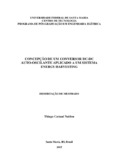| dc.creator | Naidon, Thiago Cattani | |
| dc.date.accessioned | 2019-07-08T19:42:04Z | |
| dc.date.available | 2019-07-08T19:42:04Z | |
| dc.date.issued | 2015-09-01 | |
| dc.identifier.uri | http://repositorio.ufsm.br/handle/1/17351 | |
| dc.description.abstract | This thesis aims to present the design and development of a self-oscillating DC-DC converter applied to an Energy Harvesting (EH) system. The relevance of this study is caracterized by the proposed standard analysis with the objective of defining the parameters of the design as well as providing a reduction in switching losses. The converter is designed to operate in Zero Voltage Switching (ZVS) and, thereby, to increase the efficiency and reduce the Electromagnetic Interference (EMI). The primary function of an EH system is to obtain, convert, condition and manage power from a source available in the environment. In general, this technique is used to power low power devices which usually would be powered by batteries. There are several energy sources that can be used to EH systems, however, this study focus on solar energy, for two main reasons: first, the output the panels is continuous voltage (DC) and also the high power density, which enables its use for a lot of applications. The proposed circuit is composed by a step-up self-oscillating converter, which start-up is promoted by an Greinacher multiplier voltage circuit, that acts as a auxiliary circuit. The output of the converter has a rectification stage. The circuit is capable of operating with starting voltage of at least 50 mV, and reaching output voltage values greater than 20V, with 10 mW of power. The experimental results and simulation are presented in order to demonstrate and validate the design, analysis performed with the DC-DC converter self-oscillating. | eng |
| dc.description.sponsorship | Coordenação de Aperfeiçoamento de Pessoal de Nível Superior - CAPES | por |
| dc.language | por | por |
| dc.publisher | Universidade Federal de Santa Maria | por |
| dc.rights | Attribution-NonCommercial-NoDerivatives 4.0 International | * |
| dc.rights.uri | http://creativecommons.org/licenses/by-nc-nd/4.0/ | * |
| dc.subject | Energy harvesting | por |
| dc.subject | Conversor DC-DC auto-oscilante | por |
| dc.subject | Circuito de baixa tensão e potência | por |
| dc.subject | Conversores ressonantes | por |
| dc.subject | Análise normalizada | por |
| dc.subject | Comutação suave | por |
| dc.subject | Self-oscillating DC-DC converter | eng |
| dc.subject | Low voltage and power circuit | eng |
| dc.subject | Resonant converters | eng |
| dc.subject | Standard analysis | eng |
| dc.subject | Soft switching | eng |
| dc.title | Concepção de um conversor DC-DC auto-oscilante aplicado a um sistema energy harvesting | por |
| dc.title.alternative | Design of a self-oscillating DC-DC converter applied to an energy harvesting system | eng |
| dc.type | Dissertação | por |
| dc.description.resumo | A presente dissertação tem por objetivo apresentar a concepção e o desenvolvivmento de um conversor DC-DC auto-oscilante aplicado a um sistema Energy Harvesting (EH). A relevância desse estudo se configura na análise normalizada proposta com o objetivo de parametrizar as variáveis de projeto bem como proporcionar redução nas perdas por comutação. O conversor foi projetado para operar em Zero Voltage Switching (ZVS), aumentando a eficiência e reduzindo a interferência eletromagnética. A função primordial de um sistema EH é obter, converter, condicionar e gerenciar energia proveniente de uma fonte disponível no meio ambiente, de modo que esta alimente dispositivos de baixo consumo que usualmente seriam alimentados através de pilhas ou baterias, dada a condição de que o circuito proposto opera com valores de tensão da ordem de dezenas de miliVolts. Existem diversas fontes que podem ser empregadas para sistemas EH, no entanto esse estudo manteve foco na energia solar, por dois principais motivos: a saída do sinal de foma contínua (DC) e a elevada densidade de potência, o que favorece seu uso. O circuito proposto é composto por um conversor elevador de tensão baseado em oscilador, onde a partida é promovida por um circuito auxiliar do tipo multiplicador de tensão de Greinacher e por fim um estágio de retificação através de diodos. O circuito é capaz de operar com valores de tensão de partida da ordem de 50 mV, atingindo valores de tensão de saída superiores a 20V, e potência superior a 10 mW. Os resultados experimentais e de simulação são apresentados no intuito de demonstrar e validar o projeto, análise realizados empregando o conversor DC-DC auto-oscilante. | por |
| dc.contributor.advisor1 | Campos, Alexandre | |
| dc.contributor.advisor1Lattes | http://lattes.cnpq.br/8059148083624149 | por |
| dc.contributor.referee1 | Weber, Tiago Oliveira | |
| dc.contributor.referee1Lattes | http://lattes.cnpq.br/6453626164328516 | por |
| dc.contributor.referee2 | Bonaldo, Saul Azzolin | |
| dc.contributor.referee2Lattes | http://lattes.cnpq.br/9917267334564897 | por |
| dc.creator.Lattes | http://lattes.cnpq.br/2880733901713862 | por |
| dc.publisher.country | Brasil | por |
| dc.publisher.department | Engenharia Elétrica | por |
| dc.publisher.initials | UFSM | por |
| dc.publisher.program | Programa de Pós-Graduação em Engenharia Elétrica | por |
| dc.subject.cnpq | CNPQ::ENGENHARIAS::ENGENHARIA ELETRICA | por |
| dc.publisher.unidade | Centro de Tecnologia | por |



